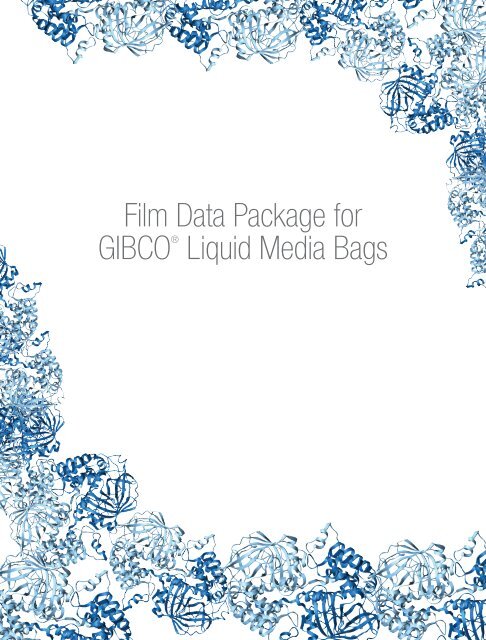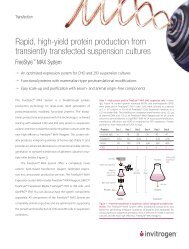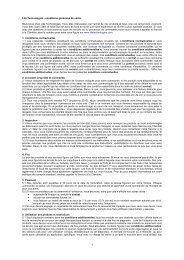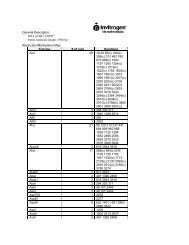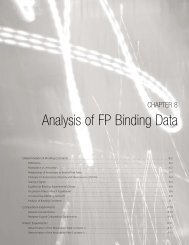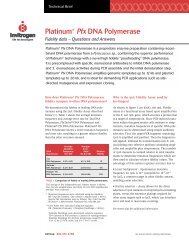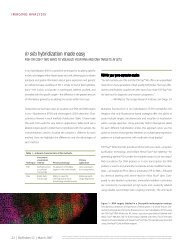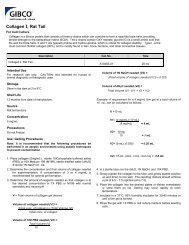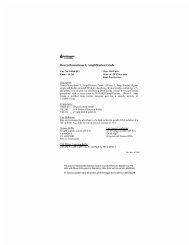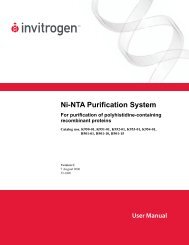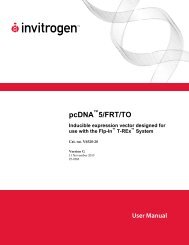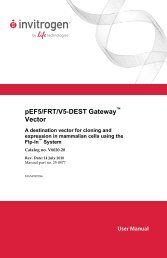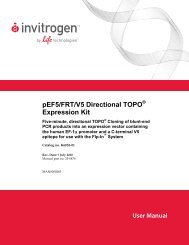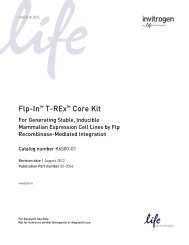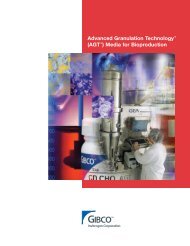Film Data Package for GIBCO® Liquid Media Bags - Invitrogen
Film Data Package for GIBCO® Liquid Media Bags - Invitrogen
Film Data Package for GIBCO® Liquid Media Bags - Invitrogen
You also want an ePaper? Increase the reach of your titles
YUMPU automatically turns print PDFs into web optimized ePapers that Google loves.
<strong>Film</strong> <strong>Data</strong> <strong>Package</strong> <strong>for</strong><br />
GIBCO ®<br />
<strong>Liquid</strong> <strong>Media</strong> <strong>Bags</strong>
Table of Contents<br />
Preface<br />
<strong>Film</strong> Technical <strong>Data</strong><br />
<strong>Film</strong> Technical <strong>Data</strong> . . . . . . . . . . . . . . . . . . . . . . . . . . . . . . . . . . . . . . . . . . . . . . . . . . . . . . . . . . . . . . . . . . . . . . . . . . . . . . .05<br />
Biological Testing<br />
USP Class VI . . . . . . . . . . . . . . . . . . . . . . . . . . . . . . . . . . . . . . . . . . . . . . . . . . . . . . . . . . . . . . . . . . . . . . . . . . . . . . . . . . . . . . .07<br />
ISO Intramuscular Implantation . . . . . . . . . . . . . . . . . . . . . . . . . . . . . . . . . . . . . . . . . . . . . . . . . . . . . . . . . . . . . . . . . . .08<br />
ISO Systemic Injection . . . . . . . . . . . . . . . . . . . . . . . . . . . . . . . . . . . . . . . . . . . . . . . . . . . . . . . . . . . . . . . . . . . . . . . . . . . .09<br />
ISO Intracutaneous Injection . . . . . . . . . . . . . . . . . . . . . . . . . . . . . . . . . . . . . . . . . . . . . . . . . . . . . . . . . . . . . . . . . . . . . .10<br />
Cytotoxicity . . . . . . . . . . . . . . . . . . . . . . . . . . . . . . . . . . . . . . . . . . . . . . . . . . . . . . . . . . . . . . . . . . . . . . . . . . . . . . . . . . . . . . .11<br />
Hemolysis. . . . . . . . . . . . . . . . . . . . . . . . . . . . . . . . . . . . . . . . . . . . . . . . . . . . . . . . . . . . . . . . . . . . . . . . . . . . . . . . . . . . . . . . .12<br />
Kligman Maximation Test . . . . . . . . . . . . . . . . . . . . . . . . . . . . . . . . . . . . . . . . . . . . . . . . . . . . . . . . . . . . . . . . . . . . . . . . .18<br />
Physicochemical Testing<br />
United States Pharmacopoeia Con<strong>for</strong>mity . . . . . . . . . . . . . . . . . . . . . . . . . . . . . . . . . . . . . . . . . . . . . . . . . . . . . . . . .20<br />
European Pharmacopoeia Con<strong>for</strong>mity . . . . . . . . . . . . . . . . . . . . . . . . . . . . . . . . . . . . . . . . . . . . . . . . . . . . . . . . . . . . .21<br />
Japanese Pharmacopoeia Con<strong>for</strong>mity . . . . . . . . . . . . . . . . . . . . . . . . . . . . . . . . . . . . . . . . . . . . . . . . . . . . . . . . . . . . .22<br />
Thai Industrial Standard Con<strong>for</strong>mity . . . . . . . . . . . . . . . . . . . . . . . . . . . . . . . . . . . . . . . . . . . . . . . . . . . . . . . . . . . . . . .23<br />
Endotoxin . . . . . . . . . . . . . . . . . . . . . . . . . . . . . . . . . . . . . . . . . . . . . . . . . . . . . . . . . . . . . . . . . . . . . . . . . . . . . . . . . . . . . . . .24<br />
Leachable Study<br />
Leachable Summary Table . . . . . . . . . . . . . . . . . . . . . . . . . . . . . . . . . . . . . . . . . . . . . . . . . . . . . . . . . . . . . . . . . . . . . . . .26<br />
Leachable Study Report . . . . . . . . . . . . . . . . . . . . . . . . . . . . . . . . . . . . . . . . . . . . . . . . . . . . . . . . . . . . . . . . . . . . . . . . . . .27<br />
Animal Origin Free Con<strong>for</strong>mity<br />
Animal Origin Free Con<strong>for</strong>mity Statement . . . . . . . . . . . . . . . . . . . . . . . . . . . . . . . . . . . . . . . . . . . . . . . . . . . . . . . . .40<br />
©2010 <strong>Invitrogen</strong> Corporation. All rights reserved. These products may be covered by one or more Limited Use Label Licenses (see <strong>Invitrogen</strong> catalog or www.invitrogen.com). By use of these products you accept the<br />
terms and conditions of all applicable Limited Use Label Licenses. For research use only. Not intended <strong>for</strong> any animal or human therapeutic or diagnostic use, unless otherwise stated. CO11506-0210<br />
www.invitrogen.com<br />
2
Throughout the basic research and industrial sectors, the name <strong>GIBCO®</strong> is synonymous with quality sera, media, and cell culture reagents.<br />
This reputation has been built on the understanding that when a company can consistently deliver quality products that reduce uncer-<br />
tainty, trust is the inevitable result. <strong>GIBCO®</strong> products embody the high per<strong>for</strong>mance and proven reliability that allow scientists to focus<br />
their attention on more important matters than troubleshooting, providing a stable foundation <strong>for</strong> successful discovery.<br />
The <strong>GIBCO®</strong> film—A better material <strong>for</strong> better<br />
media delivery<br />
While the media bag films we currently use are fully validated<br />
and acceptable, there is a growing need <strong>for</strong> a clearer, multi-layer,<br />
single-web film that can be converted into a wide range of bag<br />
sizes—from a researcher’s bench top to the needs of the larg-<br />
est industrial user. <strong>Invitrogen</strong> has found such a film—the <strong>GIBCO®</strong><br />
film—that can be used <strong>for</strong> all sizes of media bags, greatly simpli-<br />
fying your validation process. Additionally, it is superior to other<br />
commercially available films in many ways, including gas trans-<br />
mission rates, leachable/extractable properties, and clarity.<br />
Technical overview of <strong>GIBCO®</strong> film<br />
<strong>Film</strong> construction<br />
Many media bag films are dependent upon the size of bag<br />
requested; bags with less than fifty liters capacity typically have<br />
an EVA contact layer, while bags that are hundred liters or larger<br />
are most often constructed with a polyethylene contact layer.<br />
The <strong>GIBCO®</strong> film is a very clear, <strong>Film</strong> multilayered, structure <strong>for</strong> the single-web 3-ply film film<br />
PA*<br />
20 µm<br />
with a polyethylene contact surface that Outer can layer be made into a<br />
VLDPE<br />
70 µm<br />
LDPE<br />
3-ply<br />
EVOH Gas barrier layer 80 µm<br />
evaluated). In addition, the film exhibits exceptional gas barrier<br />
LDPE<br />
Total thickness = 320 µm<br />
Figure AL 1—<strong>GIBCO®</strong> = Adhesive layer; film structure. EVOH = Ethyl Employing vinyl alcohol; single-ply construction and a ULDPE con-<br />
LDPE = Low-density polyethylene; PA = Polyamide,<br />
tact PE layer, = Polyethylene; <strong>GIBCO®</strong> ULDPE film = Ultra can low-density be used <strong>for</strong> all sizes of media bags.<br />
©2010 <strong>Invitrogen</strong> Corporation. All rights reserved. These products may be covered by one or more Limited Use Label Licenses (see <strong>Invitrogen</strong> catalog or www.invitrogen.com). By use of these products you accept the<br />
terms and conditions of all applicable Limited Use Label Licenses. For research use only. Not intended <strong>for</strong> any animal or human therapeutic or diagnostic use, unless otherwise stated. CO11506-0210<br />
1-ply<br />
VLDPE<br />
PE<br />
AL<br />
EVOH<br />
AL<br />
ULDPE<br />
Contact layer 70 µm<br />
physical properties of our film are summarized in Table 1.<br />
Total thickness = 240 µm<br />
polyethylene; VLDPE = Very low-density polyethylene<br />
Preface<br />
The <strong>GIBCO®</strong> film is a single-ply material with a ULDPE contact<br />
layer (Figure 1), and is suitable <strong>for</strong> use in all sizes of media bags.<br />
Physical properties<br />
wide range of bag sizes (1L–1,000 L; other custom sizes can be<br />
properties with very low extractable and leachable results. The<br />
<strong>Film</strong> structure <strong>for</strong> single-web film (9101)<br />
Outer layer<br />
Adhesive layer<br />
Gas barrier layer<br />
Adhesive layer<br />
50 µm<br />
10 µm<br />
20 µm<br />
10 µm<br />
Contact layer 230 µm<br />
*PA is only present on sizes greater than 200 liters<br />
Table 1—Technical summary of <strong>GIBCO®</strong> film properties.<br />
Physical Property* Dimension<br />
Value<br />
(be<strong>for</strong>e/after gamma sterilization † ) Procedure<br />
Haze % 5/5 ASTM D-1003<br />
Clarity % 98/98 ASTM D-1003<br />
Transmittance % 93/93 ASTM D-1003<br />
Tensile strength at break MPa 14/13 ASTM D-882<br />
Elongation at break % 280/300 ASTM D-882<br />
Elastic modulus MPa 370350 ASTM D-882<br />
Break at cold temperature °C < –45/< –45 ISO 8570<br />
Density g/cm3 0.9 ASTM D-792<br />
Water vapor transmission rate ‡<br />
g/(m3•day) 0.35/0.32 ASTM F-1249<br />
Oxygen permeability ‡<br />
cm3/(m2•day•atm)
Testing the <strong>GIBCO®</strong> film<br />
In order to establish its suitability as a media bag material, the<br />
<strong>GIBCO®</strong> film has been extensively and rigorously tested <strong>for</strong> a<br />
wide range of properties that impact its per<strong>for</strong>mance in research<br />
and bioproduction applications:<br />
Biological suitability tests are designed to determine the<br />
biological reactivity of mammalian cell cultures and biologi-<br />
cal response of animals. A material’s biological acceptability is<br />
determined by certifying that a film meets certain industry rec-<br />
ognized standards such as EP and USP. USP Class VI certification<br />
is widely known and achieved through a series of Systemic Injec-<br />
tion, Implantation, and Intracutaneous tests; additionally, Elution<br />
tests are often included as part of the biological testing.<br />
Physicochemical tests are designed to chemically charac-<br />
terize the primary contact surfaces and its extracts. These are<br />
typically characterized through an industry recognized set of<br />
standards such as the USP , “Physicochemical Tests – Plas-<br />
tics”. The USP standard helps characterize the type of extracts<br />
through the use of non-volatile residue, residue on ignition,<br />
heavy metals and buffering capacity. These tests actively/aggres-<br />
sively try to pull chemicals from the test subject.<br />
©2010 <strong>Invitrogen</strong> Corporation. All rights reserved. These products may be covered by one or more Limited Use Label Licenses (see <strong>Invitrogen</strong> catalog or www.invitrogen.com). By use of these products you accept the<br />
terms and conditions of all applicable Limited Use Label Licenses. For research use only. Not intended <strong>for</strong> any animal or human therapeutic or diagnostic use, unless otherwise stated. CO11506-0210<br />
Chemical compatibility is the interaction of a solution,<br />
medium or reagent with that of a packaging system. Under-<br />
standing the interaction between the <strong>for</strong>mulation and packag-<br />
ing system enables the product to be successfully stored and<br />
shipped without compromising either one.<br />
Leachability testing is a passive way of determining which<br />
chemicals migrate from the film to the medium within the con-<br />
tainment system. This test is conducted in real-time, under nor-<br />
mal processing and environmental conditions.<br />
Animal origin material refers to any animal originated<br />
component or additive that may have been introduced into a<br />
packaging system through either the resin production or the<br />
manufacturing conversion processes. The films used <strong>for</strong> Invitro-<br />
gen’s products are animal origin–free.<br />
Globally recognized compendia testing is per<strong>for</strong>med on<br />
the packaging materials. These compendia include (but are not<br />
limited to) EP, USP, and JP. The use of industry-recognized stan-<br />
dard testing minimizes excursions in test methods from vendors<br />
and manufacturers alike.<br />
The results of these tests are described in detail in the<br />
remainder of this document.<br />
www.invitrogen.com<br />
4
<strong>Film</strong> Technical <strong>Data</strong>
Compound: <strong>GIBCO®</strong><br />
Product: INFUFLEX BARRIER<br />
Main polymers: PE, EVOH<br />
Main application areas: Biotechnology applications, high oxygen barrier<br />
Physical property* Dimension<br />
Value<br />
Be<strong>for</strong>e/after gamma sterilization<br />
©2010 <strong>Invitrogen</strong> Corporation. All rights reserved. These products may be covered by one or more Limited Use Label Licenses (see <strong>Invitrogen</strong> catalog or www.invitrogen.com). By use of these products you accept the<br />
terms and conditions of all applicable Limited Use Label Licenses. For research use only. Not intended <strong>for</strong> any animal or human therapeutic or diagnostic use, unless otherwise stated. CO11506-0210<br />
Procedure<br />
Haze % 5 / 5 ASTM D-1003<br />
Clarity % 98 / 98 ASTM D-1003<br />
Transmittance % 93 / 93 ASTM D-1003<br />
Tensile strength at break MPa 14 / 13 ASTM D-882<br />
Elongation at break % 280 / 300 ASTM D-882<br />
Elastic Modulus Mpa 370 / 350 ASTM D-882<br />
Break at cold temperature °C below -45 / below -45 ISO 8570<br />
Density g/cm3 0.9 ASTM D-792<br />
Water vapour transmission rate** g/(m2.day) 0.35 / 0.32 ASTM F-1249<br />
Oxygen Permeability** cm3/(m2.day.atm) < 0.05 / < 0.05 ASTM D-3985<br />
Carbondioxide Permeability** cm3/(m2.day.atm) < 0.2 / < 0.2 ASTM F-2476<br />
<strong>Film</strong> thickness: 0.325 mm<br />
<strong>Film</strong> width: 850 mm<br />
Recommended sealing method: Heat sealing<br />
Recommended sterilization method: Gamma<br />
Formulation characteristics: • Multi layer structure with inert PE<br />
fluid contact layer<br />
• Low extractables/leachables<br />
• No animal derived ingredients<br />
*Gauge test film 0.325 mm<br />
Gamma sterilization dose 25 kGy except **50 kGy<br />
<strong>Film</strong> Technical <strong>Data</strong><br />
This technical in<strong>for</strong>mation consists of typical product data and should not be used as a specification 2007/09<br />
The data contained in this document are provided in good faith <strong>for</strong> the sake of general in<strong>for</strong>mation. It is deemed to be accurate at the time of going into press. The purchaser<br />
or user is required to verify with our technical services whether any specific application is appropriate. Freedom of possession, use or marketing under intellectual property<br />
rights or legal provisions or regulations, whether national or local, must be duly considered be<strong>for</strong>e use. Under no circumstances should any Solmed film, tubing or compound<br />
be used in any cosmetic, reconstructive or any other temporary or permanent bodily implant application.<br />
www.invitrogen.com<br />
6
Biological Testing
Technical initiation: 11/30/2006<br />
Technical completion: 12/7/2006<br />
Report date: 12/11/2006<br />
Project number: 06-5591-G1<br />
Test Article Compound <strong>GIBCO®</strong> gamma gesteriliseerd<br />
Lot/Batch # 634PN<br />
Study Class VI Test − USP<br />
Ratio 120cm2/20 mL<br />
Vehicles<br />
USP 0.9% Sodium Chloride <strong>for</strong> Injection (NaCl), Cottonseed Oil (CSO), 1 in 20 Ethanol in NaCl (EtOH), and Polyethylene<br />
Glycol 400 (PEG)<br />
Extraction conditions 50 ± 2 °C <strong>for</strong> 72 ± 2 hours<br />
Comments None<br />
References<br />
The study was conducted based upon the following references:<br />
USP 29, NF 24, 2006. Biological Reactivity Tests, In Vivo.<br />
Draize Scale <strong>for</strong> Scoring Skin Reactions, Draize, J.H. “Dermal Tox-<br />
icity”, Appraisal of the Safety of Chemicals in Foods, Drugs and<br />
Cosmetics − Dermal Toxicity, pp. 49−52. Association of Food and<br />
Drug Officials of the United States, Topeka, Kansas, 1965.<br />
ISO/IEC 17025, 2005, General Requirements <strong>for</strong> the Compe-<br />
tence of Testing and Calibration Laboratories.<br />
General procedure<br />
The extraction conditions were per<strong>for</strong>med as stated above. The<br />
test article extracts and corresponding blanks were injected sys-<br />
temically and intracutaneously in mice and rabbits, respectively.<br />
The injections were in the amounts and routes set <strong>for</strong>th by USP,<br />
including the further dilution of the extracts prepared with PEG.<br />
The animals were observed <strong>for</strong> signs of toxicity and skin reactiv-<br />
ity <strong>for</strong> up to 72 hours post treatment. In addition, the test article<br />
was implanted into the paravertebral muscles of rabbits <strong>for</strong> 7<br />
days and observed macroscopically <strong>for</strong> signs of hemorrhage,<br />
necrosis, discoloration, encapsulation, and infection.<br />
Results<br />
None of the mice injected with the test article extracts exhibited<br />
any signs of toxicity in the Systemic Injection Test. In addition,<br />
none of the rabbits injected intracutaneously with the test article<br />
extracts exhibited any signs of erythema, edema or clinical tox-<br />
icity. In both the Systemic and Intracutaneous Tests the controls<br />
were normal through 72 hours. Also, the implant sites exhibited no<br />
significant signs of hemorrhage, necrosis, discoloration, encapsu-<br />
lation, or infection compared with the control sites.<br />
Conclusion<br />
The test article meets the requirements of the guidelines <strong>for</strong> the<br />
Biological Test <strong>for</strong> Plastics, Class VI − 50°C.<br />
©2010 <strong>Invitrogen</strong> Corporation. All rights reserved. These products may be covered by one or more Limited Use Label Licenses (see <strong>Invitrogen</strong> catalog or www.invitrogen.com). By use of these products you accept the<br />
terms and conditions of all applicable Limited Use Label Licenses. For research use only. Not intended <strong>for</strong> any animal or human therapeutic or diagnostic use, unless otherwise stated. CO11506-0210<br />
USP Class VI<br />
Test results<br />
www.invitrogen.com<br />
8
2 Week Implantation<br />
Project Number: 06-5174-G3<br />
Test Article: Compound <strong>GIBCO®</strong>, gamma-gesteriliseerd<br />
The relative size of the involved area was scored by assessing the<br />
width of the area from the implant/tissue interface to unaffected<br />
areas which have the characteristics of normal tissue and normal<br />
vascularity. Relative size of the involved area was scored using<br />
the following scale:<br />
0 = 0 mm No site<br />
0.5 = up to 0.5 mm Very slight<br />
1 = 0.6 − 1.0 mm Mild<br />
2 = 1.1 − 2.0 mm Moderate<br />
3 = > 2.0 mm Marked<br />
For each implanted site, a total score is determined. The average<br />
score of the test sites <strong>for</strong> each animal is compared to the average<br />
score of the control sites <strong>for</strong> that animal. The average difference<br />
between test and controls <strong>for</strong> all animals is then calculated and<br />
the initial Bioreactivity Rating is assigned as follows:<br />
0 − 1.5 No Reaction*<br />
> 1.5 − 3.5 Mild Reaction<br />
> 3.5 − 6.0 Moderate Reaction<br />
> 6.0<br />
* A negative calculation is reported as zero (0).<br />
Marked Reaction<br />
ISO Intramuscular Implantation<br />
Test results<br />
Results<br />
Macroscopic<br />
Macroscopic evaluation of the test article implant sites indicated<br />
no significant signs of inflammation, encapsulation, hemorrhage,<br />
necrosis, or discoloration at the 2 week time period.<br />
Microscopic<br />
Microscopic evaluation of the test article implant sites indicated<br />
no significant signs of inflammation, fibrosis, hemorrhage, necro-<br />
sis, or degeneration as compared to the control article sites. The<br />
Bioreactivity Rating <strong>for</strong> the 2 week time period (average of three<br />
animals) was 0.1, indicating no reaction as compared to the con-<br />
trol implant sites.<br />
Conclusion<br />
The test article was implanted in the paravertebral muscle tis-<br />
sue of New Zealand White rabbits <strong>for</strong> a period of 2 weeks. The<br />
results indicate that the test article does not demonstrate any<br />
remarkable difference as compared to the control implant sites<br />
(Bioreactivity Rating of 0.1) when implanted <strong>for</strong> 2 weeks.<br />
©2010 <strong>Invitrogen</strong> Corporation. All rights reserved. These products may be covered by one or more Limited Use Label Licenses (see <strong>Invitrogen</strong> catalog or www.invitrogen.com). By use of these products you accept the<br />
terms and conditions of all applicable Limited Use Label Licenses. For research use only. Not intended <strong>for</strong> any animal or human therapeutic or diagnostic use, unless otherwise stated. CO11506-0210<br />
www.invitrogen.com<br />
9
Technical initiation: 10/30/2006<br />
Technical completion: 11/2/2006<br />
Report date: 11/10/2006<br />
Project number: 06-5174-G2<br />
Test Article Compound <strong>GIBCO®</strong>, gamma-gesteriliseerd<br />
Lot/Batch # 634PP<br />
Study Systemic Injection Test − ISO<br />
Ratio 6 cm2/1 mL<br />
Vehicle USP 0.9% Sodium Chloride <strong>for</strong> Injection (NaCl) and Cottonseed Oil (CSO)<br />
Extraction Conditions 70 ± 2 °C <strong>for</strong> 24 ± 2 hours<br />
Comments None<br />
References<br />
The study was conducted based upon the following refer-<br />
ences: ISO 10993−11, 1993, Biological Evaluation of Medical<br />
Devices − Part 11: Tests <strong>for</strong> Systemic Toxicity. ISO 10993−12, 2002,<br />
Biological Evaluation of Medical Devices − Part 12: Sample Prepa-<br />
ration and Reference Materials.<br />
ISO/IEC 17025, 2005, General Requirements <strong>for</strong> the Compe-<br />
tence of Testing and Calibration Laboratories.<br />
General Procedure<br />
The Systemic Injection Study is designed to screen solutions<br />
and test article extracts <strong>for</strong> potential toxic effects as a result of<br />
a single−dose systemic injection in mice. The extraction condi-<br />
tions were per<strong>for</strong>med as stated above. The test article extracts<br />
were injected intravenously (NaCl) and intraperitoneally (CSO)<br />
©2010 <strong>Invitrogen</strong> Corporation. All rights reserved. These products may be covered by one or more Limited Use Label Licenses (see <strong>Invitrogen</strong> catalog or www.invitrogen.com). By use of these products you accept the<br />
terms and conditions of all applicable Limited Use Label Licenses. For research use only. Not intended <strong>for</strong> any animal or human therapeutic or diagnostic use, unless otherwise stated. CO11506-0210<br />
ISO-Systemic Injection<br />
Test results<br />
at 50 mL per kg, in groups of five mice. Similarly, groups of five<br />
mice were injected with the control articles (vehicles). The ani-<br />
mals were observed <strong>for</strong> signs of biological reactivity <strong>for</strong> 72 hours<br />
post inoculation.<br />
Results<br />
None of the animals injected with the test article extracts or the<br />
control articles (vehicles) exhibited any signs of toxicity through<br />
the observation period.<br />
Conclusion<br />
The animals treated with the test article extracts did not exhibit<br />
biological reactions greater than the controls. There<strong>for</strong>e, the test<br />
article meets the requirements of the ISO 10993−11 guidelines<br />
<strong>for</strong> the Systemic Injection Test.<br />
www.invitrogen.com<br />
10
Technical initiation: 10/30/2006<br />
Technical completion: 11/2/2006<br />
Report date: 11/10/2006<br />
Project number: 06-5174-G2<br />
Test Article Compound <strong>GIBCO®</strong>, gamma-gesteriliseerd<br />
Lot/Batch # 634PP<br />
Study Intracutaneous Injection Test − ISO<br />
Ratio 6 cm2/1 mL<br />
Vehicles USP 0.9% Sodium Chloride <strong>for</strong> Injection (NaCl) and Cottonseed Oil (CSO)<br />
Extraction Conditions 70 ± 2 °C <strong>for</strong> 24 ± 2 hours<br />
Comments None<br />
References<br />
The study was conducted based upon the following references:<br />
ISO 10993−10, 2002, Biological Evaluation of Medical Devices −<br />
Part 10: Tests <strong>for</strong> Irritation and Delayed−Type Hypersensitivity. ISO<br />
10993−12, 2002, Biological Evaluation of Medical Devices − Part<br />
12: Sample Preparation and Reference Materials.<br />
ISO/IEC 17025, 2005, General Requirements <strong>for</strong> the Compe-<br />
tence of Testing and Calibration Laboratories.<br />
General Procedure<br />
The Intracutaneous Test is designed to evaluate local responses<br />
to the extracts of test articles, following intracutaneous injection<br />
into rabbits. The extraction conditions were per<strong>for</strong>med as stated<br />
above. Control extracts were prepared, in a similar manner, with<br />
each extracting medium. Two rabbits were injected intracutane-<br />
ously, using one side of the animal <strong>for</strong> one test article extract<br />
and the other side <strong>for</strong> the other extract, at 0.2 mL per site. The<br />
injected sites were examined immediately after injection and at<br />
24, 48, and 72 hours post inoculation <strong>for</strong> gross evidence of tissue<br />
reaction such as erythema, edema, and necrosis. Observations<br />
were scored according to the Classification System <strong>for</strong> Scoring<br />
Intracutaneous Injection<br />
Test results<br />
Skin Reactions and included all clinical signs. All average ery-<br />
thema and edema scores <strong>for</strong> the test and control sites at 24, 48,<br />
and 72 hours were totaled separately and divided by 12 (2 ani-<br />
mals × 3 scoring periods × 2 scoring categories) to determine the<br />
overall mean score <strong>for</strong> the test article versus the corresponding<br />
control article. The requirements of the test are met if the differ-<br />
ence of the mean reaction score (erythema/edema) <strong>for</strong> the test<br />
article and the control article is 1.0 or less.<br />
Results<br />
Both of the test animals increased in weight. None of the animals<br />
exhibited overt signs of toxicity at any of the observation points.<br />
The requirements of the test were met because the difference<br />
of the mean reaction score <strong>for</strong> the test article and control article<br />
was 0.0.<br />
Conclusion<br />
The test article meets the requirements of the Intracutaneous<br />
Test, ISO 10993−10 guidelines using extracts prepared with NaCl<br />
and CSO.<br />
©2010 <strong>Invitrogen</strong> Corporation. All rights reserved. These products may be covered by one or more Limited Use Label Licenses (see <strong>Invitrogen</strong> catalog or www.invitrogen.com). By use of these products you accept the<br />
terms and conditions of all applicable Limited Use Label Licenses. For research use only. Not intended <strong>for</strong> any animal or human therapeutic or diagnostic use, unless otherwise stated. CO11506-0210<br />
www.invitrogen.com<br />
11
Conclusion<br />
<strong>GIBCO®</strong> batch 729XC, meets the requirements described in the Solmed Cytotoxicity Test Method.<br />
©2010 <strong>Invitrogen</strong> Corporation. All rights reserved. These products may be covered by one or more Limited Use Label Licenses (see <strong>Invitrogen</strong> catalog or www.invitrogen.com). By use of these products you accept the<br />
terms and conditions of all applicable Limited Use Label Licenses. For research use only. Not intended <strong>for</strong> any animal or human therapeutic or diagnostic use, unless otherwise stated. CO11506-0210<br />
Cytotoxicity<br />
Test results<br />
Nature of control Cytotoxicity<br />
Result +<br />
Lower limit 0<br />
Upper limit 2+<br />
We herewith represent that at the time of delivery to the customer, the material will con<strong>for</strong>m to the specification in our brochure and databases and that the material has been<br />
tested in accordance with the methods set <strong>for</strong>th on this Certificate of Analysis and has achieved the results disclosed herein. We make no other warranty, express or implied,<br />
and we hereby disclaim any warranty that the material : (i) is fit <strong>for</strong> any particular purpose or intended use by the customer, or (ii) is in compliance with any application law,<br />
regulation or ordinance.<br />
www.invitrogen.com<br />
12
Hemolysis − Human Blood − ISO<br />
Project Number: 06-5174-G5<br />
Test Article: <strong>GIBCO®</strong> gamma-gesteriliseerd<br />
Toxikon final GLP report: 06-5174-G5<br />
Test Article <strong>GIBCO®</strong> gamma-gesteriliseerd<br />
Study Hemolysis - Human blood - ISO<br />
Compliance<br />
21 CFR, Part 58<br />
Good Laboratory Practice <strong>for</strong> Non−Clinical Laboratory Studies<br />
Final Report Date November 3, 2006<br />
©2010 <strong>Invitrogen</strong> Corporation. All rights reserved. These products may be covered by one or more Limited Use Label Licenses (see <strong>Invitrogen</strong> catalog or www.invitrogen.com). By use of these products you accept the<br />
terms and conditions of all applicable Limited Use Label Licenses. For research use only. Not intended <strong>for</strong> any animal or human therapeutic or diagnostic use, unless otherwise stated. CO11506-0210<br />
Hemolysis<br />
Test results<br />
www.invitrogen.com<br />
13
Hemolysis − Human Blood − ISO<br />
Project Number: 06-5174-G5<br />
Test Article: <strong>GIBCO®</strong> gamma-gesteriliseerd<br />
Table of contents<br />
Title Page<br />
Table of Contents<br />
Study Summary<br />
Quality Assurance Statement<br />
Study Director Signature and Verification Dates<br />
1.0 Purpose<br />
2.0 References<br />
3.0 Compliance<br />
4.0 Identification of Test and Control Articles<br />
5.0 Identification of Test System<br />
6.0 Justification of Test System and Route of Administration<br />
7.0 Experimental Design and Dosage<br />
8.0 Evaluation Criteria<br />
9.0 Results<br />
10.0 Conclusion<br />
11.0 Records<br />
©2010 <strong>Invitrogen</strong> Corporation. All rights reserved. These products may be covered by one or more Limited Use Label Licenses (see <strong>Invitrogen</strong> catalog or www.invitrogen.com). By use of these products you accept the<br />
terms and conditions of all applicable Limited Use Label Licenses. For research use only. Not intended <strong>for</strong> any animal or human therapeutic or diagnostic use, unless otherwise stated. CO11506-0210<br />
www.invitrogen.com<br />
14
Hemolysis − Human Blood − ISO<br />
Project Number: 06-5174-G5<br />
Test Article: <strong>GIBCO®</strong> gamma-gesteriliseerd<br />
Study summary<br />
The test article, <strong>GIBCO®</strong> gamma-gesteriliseerd, exhibited 0.0%<br />
hemolysis. The test article is considered non−hemolytic under<br />
the experimental conditions employed.<br />
Quality assurance statement<br />
This study was conducted in compliance with U.S. Food and<br />
Drug Administration regulations set <strong>for</strong>th in 21 CFR, Part 58.<br />
Inspections Date of inspection Date reported study director Date reported management<br />
Addition of blood 10/24/06 10/24/06 10/24/06<br />
Raw data 11/03/06 11/03/06 11/03/06<br />
Final report 11/03/06 11/03/06 11/03/06<br />
©2010 <strong>Invitrogen</strong> Corporation. All rights reserved. These products may be covered by one or more Limited Use Label Licenses (see <strong>Invitrogen</strong> catalog or www.invitrogen.com). By use of these products you accept the<br />
terms and conditions of all applicable Limited Use Label Licenses. For research use only. Not intended <strong>for</strong> any animal or human therapeutic or diagnostic use, unless otherwise stated. CO11506-0210<br />
The sections of the regulations not per<strong>for</strong>med by or under<br />
the direction of Toxikon Corporation, exempt from this Good<br />
Laboratory Practice Statement, included characterization and<br />
stability of the test article and its mixture with carriers, 21 CFR,<br />
Parts 58.105 and 58.113.<br />
The Quality Assurance Unit conducted inspections on the following dates. The findings were reported to the Study Director and to<br />
Toxikon’s Management.<br />
Study director signature and verification dates<br />
This study meets the technical requirements of the protocol. The study also meets with the requirements of the Good Laboratory Prac-<br />
tice Regulations, 21 CFR, Part 58, with the exemptions as stated in the Quality Assurance Statement.<br />
Verification dates:<br />
Protocol Effective Date: 10/12/06<br />
Test Article Receipt: 10/17/06<br />
Project Log Date: 10/20/06<br />
Technical Initiation: 10/24/06<br />
Technical Completion: 10/24/06<br />
www.invitrogen.com<br />
15
Hemolysis − Human Blood − ISO<br />
Project Number: 06-5174-G5<br />
Test Article: <strong>GIBCO®</strong> gamma-gesteriliseerd<br />
1.0 Purpose<br />
The purpose of the study was to assess the hemolytic activity of<br />
the test article in direct contact with human blood.<br />
2.0 References<br />
The study was conducted based upon the following references:<br />
2.1 ISO 10993−4, 2002, Biological Evaluation of Medical<br />
Devices − Part 4: Selection of Tests <strong>for</strong> Interactions with<br />
Blood, as amended 2006.<br />
2.2 Autian Method, ATTP−I, Material Sciences Toxicology<br />
Laboratories, University of Tennessee Center <strong>for</strong> the<br />
Health Sciences, Memphis, TN, April 18, 1977.<br />
2.3 Hemolysis − Rabbit Blood, Evaluation of Hemodialyz-<br />
ers and Dialysis Membranes, DHEW Publication # (NIH)<br />
77−1294, pg. 213, 1977.<br />
2.4 ISO 10993−12, 2002, Biological Evaluation of Medical<br />
Devices − Part 12: Sample Preparation and Reference<br />
Materials.<br />
2.5 ISO/IEC 17025, 2005, General Requirements <strong>for</strong> the<br />
Competence of Testing and Calibration Laboratories.<br />
3.0 Compliance<br />
The study con<strong>for</strong>med to the current FDA 21 CFR, Part 58 − Good<br />
Laboratory Practice <strong>for</strong> Non−Clinical Laboratory Studies.<br />
4.0 Identification of test and control articles<br />
The Sponsor supplied the following in<strong>for</strong>mation on a test requisi-<br />
tion <strong>for</strong>m or other correspondence, wherever applicable (exclud-<br />
ing confidential or trade secret in<strong>for</strong>mation). The Sponsor was<br />
responsible <strong>for</strong> all test article characterization data as specified<br />
in the GLP regulations.<br />
4.1 Test Article:<br />
©2010 <strong>Invitrogen</strong> Corporation. All rights reserved. These products may be covered by one or more Limited Use Label Licenses (see <strong>Invitrogen</strong> catalog or www.invitrogen.com). By use of these products you accept the<br />
terms and conditions of all applicable Limited Use Label Licenses. For research use only. Not intended <strong>for</strong> any animal or human therapeutic or diagnostic use, unless otherwise stated. CO11506-0210<br />
Test Article Name: <strong>GIBCO®</strong> gamma-gesteriliseerd<br />
CAS/Code #: Not Supplied by Sponsor (N/S)<br />
Lot/Batch #: 634PP<br />
Physical State: N/S<br />
Color: N/S<br />
Expiration Date: N/S<br />
Density: N/S<br />
Stability: N/S<br />
Solubility: N/S<br />
pH: N/S<br />
Storage Conditions: Room Temperature<br />
Safety Precautions: Standard Laboratory Safety<br />
Precautions<br />
4.2 Control Articles (Toxikon Supplied):<br />
4.2.1 Negative Control Article Name: USP 0.9% Sodium<br />
Chloride <strong>for</strong> Injection (NaCl)<br />
Toxikon QC #: CSC-06-09-003-GT<br />
Physical State: <strong>Liquid</strong><br />
Color: Colorless<br />
Stability: Stable at Room Temperature<br />
Storage Conditions: Room Temperature<br />
Safety Precautions: Standard Laboratory Safety<br />
Precautions<br />
4.2.2 Positive Control Article Name: Sterile Water <strong>for</strong><br />
Injection (SWFI)<br />
Toxikon QC #: CSC-06-08-036-CC<br />
Physical State: <strong>Liquid</strong><br />
Color: Colorless<br />
Stability: Stable at Room Temperature<br />
Storage Conditions: Room Temperature<br />
Safety Precautions: Standard Laboratory Safety<br />
Precautions<br />
www.invitrogen.com<br />
16
Hemolysis − Human Blood − ISO<br />
Project Number: 06-5174-G5<br />
Test Article: <strong>GIBCO®</strong> gamma-gesteriliseerd<br />
5.0 Identification Of Test System<br />
Human blood was utilized in evaluating the effect of a test arti-<br />
cle on the cellular components of blood when in direct contact.<br />
Human blood was obtained from donors at Toxikon Corporation,<br />
Bed<strong>for</strong>d, MA.<br />
6.0 Justification Of Test System And Route Of<br />
Administration<br />
6.1 The system <strong>for</strong> the determination of hemolytic activity<br />
of a test article, when in direct contact with human<br />
blood, is recommended in the DHEW Publication,<br />
Evaluation of Hemodialyzers and Dialysis Membranes.<br />
The guidelines have no alternative methods.<br />
6.2 The system <strong>for</strong> the determination of hemolytic<br />
activity of a test article when in direct contact with<br />
human blood is designed to simulate the conditions<br />
of the use of the test article. Evaluation of blood<br />
compatibility was a significant screening test because<br />
elevated plasma hemoglobin levels reflect red blood<br />
cell lysis upon direct contact with material and devices<br />
and is a requirement to assess effects on blood, per<br />
ISO 10993−4 guidelines.<br />
6.3 The test article was administered in vitro, directly<br />
to the test system. The route of administration was<br />
recommended by the references in Section 2.0.<br />
7.0 Experimental Design And Dosage<br />
7.1 Pre−Dose Procedure:<br />
Blood Sample:<br />
©2010 <strong>Invitrogen</strong> Corporation. All rights reserved. These products may be covered by one or more Limited Use Label Licenses (see <strong>Invitrogen</strong> catalog or www.invitrogen.com). By use of these products you accept the<br />
terms and conditions of all applicable Limited Use Label Licenses. For research use only. Not intended <strong>for</strong> any animal or human therapeutic or diagnostic use, unless otherwise stated. CO11506-0210<br />
Fresh, whole human blood was collected into EDTA−<br />
coated vacutainer tubes and was utilized within<br />
one hour of collection. It was diluted sufficiently in<br />
NaCl until 0.2 mL was hemolyzed in 10 mL of SWFI<br />
and the spectrophotometric reading at 545 nm was<br />
approximately 1.0 Absorbance unit (A).<br />
7.2 Dose Administration:<br />
7.2.1 Test Article:<br />
The test article was added to each of three test vials<br />
containing NaCl at a ratio of 0.5 g test article per 10<br />
mL of NaCl.<br />
7.2.2 Positive Control Article:<br />
A volume of 10 mL of SWFI was added to each positive<br />
control vial.<br />
7.2.3 Negative Control Article:<br />
A volume of 10 mL of NaCl was added to each negative<br />
control vial.<br />
7.2.4 Replication:<br />
The test article as well as the positive and negative<br />
controls were tested in triplicate.<br />
7.3 Post−Dose Procedure:<br />
7.3.1 All vials were incubated in a 37 ± 2 °C water bath <strong>for</strong><br />
30 minutes.<br />
7.3.2 Diluted human blood was added to all vials at a ratio<br />
of 0.2 mL blood per 10 mL article.<br />
7.3.3 All vials were then incubated in a 37 ± 2 °C water<br />
bath <strong>for</strong> 60 minutes. After incubation, the vials were<br />
centrifuged <strong>for</strong> five minutes at approximately 500 x g.<br />
7.3.4 Absorbance of each supernatant was determined<br />
against a NaCl blank at 545 nm.<br />
www.invitrogen.com<br />
17
Hemolysis − Human Blood − ISO<br />
Project Number: 06-5174-G5<br />
Test Article: <strong>GIBCO®</strong> gamma-gesteriliseerd<br />
8.0 Evaluation Criteria<br />
8.1 The average absorbance values are used to determine<br />
the percent (%) Hemolysis of the test article.<br />
% Hemolysis = Ave. Abs. of Test Article − Ave. Abs. of<br />
Negative Control × 100<br />
Ave. Abs. of Positive Control − Ave. Abs. of Negative<br />
Control<br />
8.2 The test article is considered hemolytic if it causes<br />
greater than 5% hemolysis.<br />
8.3 If deemed necessary by the Study Director, a retest<br />
is per<strong>for</strong>med using fresh blood from the same donor<br />
and a new test article.<br />
8.4 The study and its design employ methodology to<br />
9.0 Results<br />
minimize uncertainty of measurement and control of<br />
bias <strong>for</strong> data collection and analysis.<br />
Test Article Tube #1 Absorbance = 0.011<br />
Test Article Tube #2 Absorbance = 0.012<br />
Test Article Tube #3 Absorbance = 0.015<br />
Positive Control Article Tube #1 Absorbance = 1.003<br />
Positive Control Article Tube #2 Absorbance = 1.005<br />
Positive Control Article Tube #3 Absorbance = 1.004<br />
Negative Control Article Tube #1 Absorbance = 0.015<br />
Negative Control Article Tube #2 Absorbance = 0.014<br />
Negative Control Article Tube #3 Absorbance = 0.012<br />
Average Test Article Absorbance = 0.013<br />
Average Positive Control Article Absorbance = 1.004<br />
Average Negative Control Article Absorbance = 0.014<br />
Hemolysis = 0.0%<br />
10.0 Conclusion<br />
The test article, <strong>GIBCO®</strong> gamma-gesteriliseerd, exhibited 0.0%<br />
hemolysis. The test article is considered non−hemolytic under<br />
the experimental conditions employed.<br />
11.0 Records<br />
©2010 <strong>Invitrogen</strong> Corporation. All rights reserved. These products may be covered by one or more Limited Use Label Licenses (see <strong>Invitrogen</strong> catalog or www.invitrogen.com). By use of these products you accept the<br />
terms and conditions of all applicable Limited Use Label Licenses. For research use only. Not intended <strong>for</strong> any animal or human therapeutic or diagnostic use, unless otherwise stated. CO11506-0210<br />
11.1 Original raw data are archived at Toxikon Corporation.<br />
11.2 A copy of the final report and any report amendments<br />
is archived at Toxikon Corporation.<br />
11.3 The original final report, and a copy of any protocol<br />
amendments or deviations, is <strong>for</strong>warded to the<br />
Sponsor.<br />
11.4 All unused test article shall be disposed of by Toxikon.<br />
www.invitrogen.com<br />
18
Technical Initiation: 10/31/2006<br />
Technical Completion: 11/27/2006<br />
Report Date: 2/27/2007<br />
Project Number: 06-5174-G4<br />
Test Article Compound <strong>GIBCO®</strong>, gamma-gesteriliseerd<br />
Lot/Batch # 634PP<br />
Study Kligman Maximization Test - ISO<br />
Ratio 6 cm2/1 mL<br />
Vehicle USP 0.9% Sodium Chloride <strong>for</strong> Injection (NaCl) and Cottonseed Oil (CSO)<br />
Extraction Conditions 70 ± 2 °C <strong>for</strong> 24 ± 2 hours<br />
Comments None<br />
References<br />
The study was conducted based upon the following references:<br />
ISO 10993−10, 2002, Biological Evaluation of Medical Devices −<br />
Part 10: Tests <strong>for</strong> Irritation and Delayed−Type Hypersensitivity.<br />
ISO 10993−12, 2002, Biological Evaluation of Medical Devices −<br />
Part 12: Sample Preparation and Reference Materials. Zhai, H. and<br />
H.I. Maibach, eds. Dermatotoxicology. 6th edition. Boca Raton:<br />
CRC Press, 2004. 729−732. Magnusson, B. and A.M. Kligman. “The<br />
Identification of Contact Allergens by Animal Assay. The Guinea<br />
Pig Maximization Test.” J. Invest. Dermatol. 52 (1969): 268−276.<br />
Magnusson, B. and A.M. Kligman, Allergic Contact Dermatitis in<br />
the Guinea Pig. Identification of Contact Allergens. Springfield,<br />
IL.: Thomas, 1970.<br />
ISO/IEC 17025, 2005, General Requirements <strong>for</strong> the Compe-<br />
tence of Testing and Calibration Laboratories.<br />
General procedure<br />
The purpose of the study was to detect the allergenic potential<br />
of a test article. Hartley guinea pigs, 20 experimental, 10 nega-<br />
tive control, and 5 positive control, were used <strong>for</strong> this study. The<br />
test article was extracted at the conditions specified above. The<br />
Induction Phase (Day 0) was conducted by intradermally inject-<br />
ing the test article extracts or controls. The Topical Application<br />
©2010 <strong>Invitrogen</strong> Corporation. All rights reserved. These products may be covered by one or more Limited Use Label Licenses (see <strong>Invitrogen</strong> catalog or www.invitrogen.com). By use of these products you accept the<br />
terms and conditions of all applicable Limited Use Label Licenses. For research use only. Not intended <strong>for</strong> any animal or human therapeutic or diagnostic use, unless otherwise stated. CO11506-0210<br />
Kligman Maximization<br />
Test results<br />
Phase (Day 7) was conducted by applying the test article extract<br />
or control article <strong>for</strong> 48 hours, at the site of the intradermal injec-<br />
tions. The 24 hour Challenge Phase was per<strong>for</strong>med on Day 23.<br />
Test and control animals were scored <strong>for</strong> erythema and edema<br />
according to the Classification System <strong>for</strong> Scoring Skin Reactions<br />
at 24, 48, and 72 hours post Challenge Phase. The study and its<br />
design employed methodology to minimize uncertainty of mea-<br />
surement and control or bias <strong>for</strong> data collection and analysis.<br />
Results<br />
The skin sites that were exposed to the test article extracts and<br />
negative control showed no signs of erythema or edema. The<br />
skin sites exposed to the positive control showed the expected<br />
signs of erythema and edema.<br />
Conclusion<br />
The skin treated with the test article extracts exhibited no reac-<br />
tion to the challenge (0% sensitization). There<strong>for</strong>e, as defined by<br />
the scoring system of Kligman, this is a Grade I reaction and the<br />
test article extracts (as prepared) are classified as having weak<br />
allergenic potential. A Grade I sensitization rate is not considered<br />
significant.<br />
www.invitrogen.com<br />
19
Physicochemical Testing
Title<br />
Tests according toUSP28/NF20, Edition 2006, General Chapter<br />
, page 2657-2658, on Solmed® Formulation <strong>GIBCO®</strong> inner-<br />
layer gamma radiated 25 kGy<br />
Background<br />
General Chapter USP CONTAINERS describes several<br />
chemical tests. The laboratory of Renolit Nederland BV has per-<br />
<strong>for</strong>med the tests according to European Pharmacopoeia 5th edi-<br />
tion, supplement 2005, 3.1.6 and specific according to USP 28/<br />
NF20, Edition 2006, General Chapter , page 2657-2658 <strong>for</strong><br />
Buffering Capacity and Novolatile Residu.. This combination of<br />
test results was per<strong>for</strong>med to show compliance with all USP 661<br />
specifications <strong>for</strong> plastic containers.<br />
Methods of analysis<br />
See USP28/NF20, Edition 2006, General Chapter , page<br />
2657-2658<br />
Conclusion<br />
The tested <strong>for</strong>mulation meets the test-requirements as described<br />
in USP28/NF20, Edition 2006, General Chapter CONTAIN-<br />
ERS, Physico-Chemical Tests – Plastics.<br />
Test Result Specification<br />
Buffer Capacity 0.10 ml Difference between volume sample and blank
Product tested: Compound <strong>GIBCO®</strong><br />
Batch: 200609A-Innerlayer gamma radiated 25kGy<br />
Sample code: 2007020315<br />
Quality System: ISO9001/ISO13485<br />
Test Method<br />
See European Pharmacopoeia 5th edition 3.1.5, 2005 Material<br />
based on Polyethylene <strong>for</strong> containers and closures <strong>for</strong> prepara-<br />
tion and <strong>for</strong> parenteral and ophthalmic use<br />
Analysis realized by<br />
Quality Control Laboratory Renolit Nederland BV<br />
Conclusion<br />
©2010 <strong>Invitrogen</strong> Corporation. All rights reserved. These products may be covered by one or more Limited Use Label Licenses (see <strong>Invitrogen</strong> catalog or www.invitrogen.com). By use of these products you accept the<br />
terms and conditions of all applicable Limited Use Label Licenses. For research use only. Not intended <strong>for</strong> any animal or human therapeutic or diagnostic use, unless otherwise stated. CO11506-0210<br />
EP Con<strong>for</strong>mity<br />
Test results<br />
Renolit Nederland B.V compound <strong>GIBCO®</strong> batch 200609A-Inner-<br />
layer gamma irradiated 25kGy meets the relevant test require-<br />
ments described in the European Pharmacopoeia 5th edition.<br />
Monograph 3.1.5, 2005<br />
Nature of Control Results Specification<br />
Characters Pass Pass<br />
Identifiction A-I.R. spectrophotometry Pass Pass<br />
B-additives present Pass Pass<br />
C-Titanium-dioxide (1) Pass Pass<br />
Test Appearance of solution (2) Pass Pass<br />
Acidity 0.34 ≤1.5 ml NaOH<br />
Alkalinity 0.39 ≤1.0 ml HCI<br />
UV absorbance (220-340nm) 0.15 ≤0.20 abs<br />
Reducing substances 0.35 ≤0.5 ml KMnO4<br />
Substances soluble in hexane Not relevant Due to composition of product<br />
Extractable aluminum (1) Pass ≤1.0 ppm<br />
Extractable chromium (1) Pass ≤0.05 ppm<br />
Extractable titanium (1) Pass ≤1.0 ppm<br />
Extractable vanadium (1) Pass ≤0.01 ppm<br />
Extractable zirconium (1) Pass ≤0.1 ppm<br />
Extractable zinc (1) Pass ≤1.0 ppm<br />
Extractable heavy metals (1) Pass ≤2.0 ppm<br />
Sulphated ash 0.00 ≤1.0 %<br />
max. 3 antioxidants Pass Pass<br />
Product Tested: Compound 910<br />
Batch: 6061514ffh inner layer<br />
Sample code: 20007020311<br />
Test Method<br />
See Japanese Pharmacopoeia XIV, 2001Test method <strong>for</strong> plastic<br />
containers<br />
Analysis realized by<br />
Quality Control Laboratory Renolit Nederland BV<br />
Conclusion<br />
©2010 <strong>Invitrogen</strong> Corporation. All rights reserved. These products may be covered by one or more Limited Use Label Licenses (see <strong>Invitrogen</strong> catalog or www.invitrogen.com). By use of these products you accept the<br />
terms and conditions of all applicable Limited Use Label Licenses. For research use only. Not intended <strong>for</strong> any animal or human therapeutic or diagnostic use, unless otherwise stated. CO11506-0210<br />
JP Con<strong>for</strong>mity<br />
Test results<br />
Renolit Nederland BV compound <strong>GIBCO®</strong> batch 6061514ffh inner<br />
layer meets the test requirement described in the Japanese<br />
Pharmacopoeia XIV, 2001 test methods <strong>for</strong> plastic containers<br />
Test Lower limit Upper limit Result Unit<br />
Cytotoxicity 0 2+ + -<br />
Cadmium (1) 0 1 0 ppm<br />
Lead (1) 0 10 < 1 ppm<br />
Tin (1) 0 5 1 ppm<br />
Heavy metals (1) Pass -<br />
Residue on ignition 0.00 0.10 0.01 %<br />
Residue on evaporation 0.0 0.5 0.0 mg/20ml<br />
pH shift -1.5 1.5 0.4 -<br />
Reducing substances 0.0 1.0 0.0 ml KMnO4<br />
UV 220-240nm 0.00 0.08 0.03 abs<br />
UV 241-350nm 0.00 0.05 0.02 abs<br />
1. ICP is used <strong>for</strong> analytical reasons<br />
2. Active cells toxicity test on Human Embryonal cells<br />
3. ISO 10993-5, University of Amstradam<br />
www.invitrogen.com<br />
23
Product Tested: Compound 910<br />
Batch: 634PD inner layer gamma irradiated 25kGy<br />
Sample code: 20007030587<br />
Quality System: ISO9001/ISO13485<br />
Test Method<br />
See Thai Industrial Standard Tis531-2536 (1993)<br />
Plastic containers <strong>for</strong> sterile pharmaceutical products<br />
Analysis realized by<br />
Quality Control Laboratory Renolit Nederland BV<br />
Conclusion<br />
©2010 <strong>Invitrogen</strong> Corporation. All rights reserved. These products may be covered by one or more Limited Use Label Licenses (see <strong>Invitrogen</strong> catalog or www.invitrogen.com). By use of these products you accept the<br />
terms and conditions of all applicable Limited Use Label Licenses. For research use only. Not intended <strong>for</strong> any animal or human therapeutic or diagnostic use, unless otherwise stated. CO11506-0210<br />
Thai Con<strong>for</strong>mity<br />
Test Results<br />
Renolit Nederland BV compound <strong>GIBCO®</strong> batch 634PD inner layer<br />
gamma irradiated 25kGy meets the test requirement described<br />
in the Thai Industrial Standard, Plastic containers <strong>for</strong> sterile phar-<br />
maceutical products.<br />
Test Lower limit Upper limit Result Unit<br />
Cytotoxicity 0 2+ + -<br />
Cadmium (1) 0 1 0 ppm<br />
Lead (1) 0 10 < 1 ppm<br />
Tin (1) 0 5 1 ppm<br />
Heavy metals (1) Pass -<br />
Residue on ignition 0.00 0.10 0.01 %<br />
Residue on evaporation 0.0 0.5 0.0 mg/20ml<br />
Zn in extract 0.0 0.5 < 0.02 ppm<br />
pH shift -1.5 1.5 0.4 -<br />
Reducing substances 0.0 1.0 0.0 ml KMnO4<br />
UV 220-240nm 0.00 0.08 0.03 abs<br />
UV 241-350nm 0.00 0.05 0.02 abs<br />
1. ICP is used <strong>for</strong> analytical reasons<br />
2. Active cells toxicity test on Human Embryonal cells<br />
3. ISO 10993-5, University of Amsterdam<br />
www.invitrogen.com<br />
24
Project Number TE 06674<br />
Study Number 06-B2171-N1<br />
Report Date: 19/10/2007<br />
©2010 <strong>Invitrogen</strong> Corporation. All rights reserved. These products may be covered by one or more Limited Use Label Licenses (see <strong>Invitrogen</strong> catalog or www.invitrogen.com). By use of these products you accept the<br />
terms and conditions of all applicable Limited Use Label Licenses. For research use only. Not intended <strong>for</strong> any animal or human therapeutic or diagnostic use, unless otherwise stated. CO11506-0210<br />
Endotoxin<br />
Test results<br />
Study: Amebocyte Lysate Test-Kinetic-QCL Method<br />
Test: Item <strong>GIBCO®</strong> gamma gesteriliseerd Influflex<br />
Lot #: 634PP<br />
Reference: Base don ‘USP 29-NF 24, 2006, ‘Bacterial Endotoxin Test’ and ‘Guidelines on Validation of the LAL test as an End Product Endotoxin Test<br />
<strong>for</strong> Human and Animal Perenteral Drugs, Biological Products and Medical Devices, FDA December 1987<br />
Procedure<br />
A bag with a surface area of 60cm2 was made from a test article,<br />
filled with 20ml of LAL Reagent water and extracted <strong>for</strong> 1hr. A<br />
standard curve of endotoxin (Cambrex brand) was prepared<br />
with concentrations of 0.005,0.05, 0.5,5 and 50EU/ml. A positive<br />
product control was prepared to give a final concentration of<br />
0.5EU/ml. LAL Reagent water served as a negative control. The<br />
microtiter plate was preincubated in the plate reader at 37+-1C<br />
<strong>for</strong> ≥10 minutes.After incubation kinetic QCL-Reagent (0.1ml) was<br />
added to each well and the absorbance of each well at 405nm<br />
was read every 150 seconds <strong>for</strong> a total of 40 data points or until<br />
the concentration reaches 0.2 absorbance units. The Kinetic QCL<br />
reader uses the initial reading of each well as its own blank. The<br />
absolute value of the correlation coefficient (r) must be ≥0.980 in<br />
order <strong>for</strong> the test to be valid.<br />
Results<br />
Dilution 1:1 EU/ml
Leachable Study
Leve ls<br />
©2010 <strong>Invitrogen</strong> Corporation. All rights reserved. These products may be covered by one or more Limited Use Label Licenses (see <strong>Invitrogen</strong> catalog or www.invitrogen.com). By use of these products you accept the<br />
terms and conditions of all applicable Limited Use Label Licenses. For research use only. Not intended <strong>for</strong> any animal or human therapeutic or diagnostic use, unless otherwise stated. CO11506-0210<br />
Leachable Study<br />
Summary Table<br />
WFI WFI – pH 3 WFI – pH 11<br />
Extractant<br />
3M NaCl 96% Ethanol 1% Tween 80 10% DMSO<br />
2 – 10<br />
ppm<br />
1,3-di-tertbutylbenzene<br />
(5.3 ppm)<br />
1 – 2<br />
ppm<br />
TOC TOC<br />
C8 –alkenes<br />
(
91 Days Leachables Study On Gamma Irradiated Articles Made<br />
Of Solmed® Polyethylene Based Materials<br />
Solmed® materials used:<br />
→ Infuflex <strong>GIBCO®</strong><br />
→ Tubeflex 4101<br />
→ Granuflex 4301<br />
Normative basis:<br />
→ ISO 10993-17, and -18 [Chemical Characterization of Medical Devices]<br />
→ European Pharmacopoeia, 5th Edition (2005 + supplements).<br />
©2010 <strong>Invitrogen</strong> Corporation. All rights reserved. These products may be covered by one or more Limited Use Label Licenses (see <strong>Invitrogen</strong> catalog or www.invitrogen.com). By use of these products you accept the<br />
terms and conditions of all applicable Limited Use Label Licenses. For research use only. Not intended <strong>for</strong> any animal or human therapeutic or diagnostic use, unless otherwise stated. CO11506-0210<br />
Leachable Study<br />
Test report<br />
www.invitrogen.com<br />
28
Contents<br />
I. Summary<br />
Aggregated Table of Findings<br />
II. Introduction<br />
A. Study Outline<br />
A.1.Samples Description<br />
A.2.Extraction Fluids<br />
A.3.Analytical methods and chemical entities aimed <strong>for</strong><br />
A.3.1. Acidity / Alkalinity<br />
A.3.2. Conductivity<br />
A.3.3. Total organic Carbon<br />
A.3.4. Metal Ions – ICP-OES<br />
A.3.5. Acetate/Formate – Ion Chromatography<br />
A.3.6. Volatile organic compounds / Headspace GC/MS<br />
A.3.7. Semi-volatile organic compounds / GC/MS<br />
A.3.8. Non-volatile organic compounds / LC/MS<br />
A.3.9. Derivatization GC/MS<br />
A.4 .Identification<br />
A.5. Quantification<br />
B. Results / Findings<br />
B.1. Water <strong>for</strong> Injection<br />
B.2. Phosphate buffer solution pH 3<br />
B.3. Phosphate buffer solution pH 11<br />
B.4. Sodium Chloride 3M<br />
B.5. Ethanol 96%<br />
B.6. 1% Tween 80<br />
B.7. 10% DMSO<br />
C. Conclusions<br />
Aggregated Table of Findings<br />
©2010 <strong>Invitrogen</strong> Corporation. All rights reserved. These products may be covered by one or more Limited Use Label Licenses (see <strong>Invitrogen</strong> catalog or www.invitrogen.com). By use of these products you accept the<br />
terms and conditions of all applicable Limited Use Label Licenses. For research use only. Not intended <strong>for</strong> any animal or human therapeutic or diagnostic use, unless otherwise stated. CO11506-0210<br />
www.invitrogen.com<br />
29
Chemical Characterization Of Solmed® Polyethylene Based Products (Ix <strong>GIBCO®</strong> – Tx 4101 – Gx 4301)<br />
After Gamma Irradiation<br />
I. Summary<br />
Preparation<br />
In co-operation with a well-known bags maker articles (empty<br />
bags) made of Solmed® Infuflex <strong>GIBCO®</strong> film, Tubeflex 4101 tub-<br />
ing and Granuflex 4301 injection moulding compound were<br />
manufactured, gamma sterilized (25 kGy) and sent to Toxikon<br />
Europe to be filled with one of 7 contact fluids:<br />
→ Water <strong>for</strong> Injection (WFI),<br />
→ PBS(saline) pH3,<br />
→ PBS (saline) pH 11,<br />
→ NaCl 3M,<br />
→ Ethanol 96%,<br />
→ 1% Tween 80,<br />
→ 10% DMSO).<br />
The filled bags were climatized at 40ºC-75% Relative Humidity<br />
and samples were taken at T=0, T= 30 days, T=91 days. The bags<br />
were filled according to a surface to content ratio of 2cm2/mL<br />
GX 4301 material has been examined in the WFI test only.<br />
©2010 <strong>Invitrogen</strong> Corporation. All rights reserved. These products may be covered by one or more Limited Use Label Licenses (see <strong>Invitrogen</strong> catalog or www.invitrogen.com). By use of these products you accept the<br />
terms and conditions of all applicable Limited Use Label Licenses. For research use only. Not intended <strong>for</strong> any animal or human therapeutic or diagnostic use, unless otherwise stated. CO11506-0210<br />
Various analytical methods were used, aiming <strong>for</strong> different<br />
groeps of molecules, e.g. ICP-AES <strong>for</strong> metals, Headspace Gaschro-<br />
matography/Mass Spectrography <strong>for</strong> volatiles, etc.<br />
All analytical assays were per<strong>for</strong>med against a blank (in<br />
glass container).<br />
Results<br />
Examples of molecules found are reaction products of antioxi-<br />
dants, oligomers from the Polyethylene articles, and their reac-<br />
tion products.<br />
As expected, the Ethanol, Tween and DMSO contact fluids<br />
showed the most extractables, but the highest concentration of<br />
any extractable found in this study was approx. 5.3 ppm <strong>for</strong> 1,3-<br />
Di-tert-butylbenzene (a reaction product coming from certain<br />
phenolic antioxidants.<br />
Based on the findings from this study we can say, that the<br />
30 days and the 91 days test results only revealed extractable<br />
chemical entities that were expected, with most concentrations<br />
in the ppb – 1 ppm range.<br />
www.invitrogen.com<br />
30
Aggregated Table of Findings<br />
Levels<br />
WFI PBS – pH 3 PBS – pH 11<br />
Extractant<br />
3M NaCl 96% Ethanol 1% Tween 80 10% DMSO<br />
2 – 10<br />
ppm<br />
1,3-di-tertbutylbenzene<br />
(5.3 ppm)<br />
1 – 2<br />
TOC<br />
TOC<br />
C8 –alkenes<br />
ppm<br />
(1.3 ppm C/L) (1.1 ppm C/L)<br />
(
II. 91 Days Leachables Study Of Gamma Irradiated<br />
Articles Made Of Solmed® Formulations<br />
<strong>GIBCO®</strong> – 4101 - 4301.<br />
Introduction<br />
Solmed® plastic products are being used worldwide <strong>for</strong> the<br />
manufacture of medical devices and pharmaeutical packaging<br />
such as infusion bags, blood bags, biotech reactors, etc.<br />
An extractables study has been per<strong>for</strong>med on the Solmed®<br />
newly developed family of Polyethylene based products aimed<br />
<strong>for</strong> use in biotechnological processes:<br />
→ Infuflex <strong>GIBCO®</strong> film<br />
→ Tubeflex 4101 tubing<br />
→ Granuflex 4301 injection moulding compound<br />
This study has been set up with the aim to provide our customers<br />
and the final users of systems made of Infuflex <strong>GIBCO®</strong>, Tubeflex<br />
4101 and Granuflex 4301 with in<strong>for</strong>mation regarding the extract-<br />
ables coming from these materials at well defined and rigorous<br />
conditions with standard extractants (contact fluids).<br />
It remains the responsibility of our customer, or the end<br />
user to make sure that articles made of these materials are suited<br />
<strong>for</strong> the intended purpose or use and are in compliance with any<br />
applicable law, regulation or ordinance.<br />
A. Study Outline<br />
A.1. Samples Description<br />
In co-operation with an external bag making company bags<br />
with a regular design were welded, comprising one small bore<br />
filling tube. Tubes were closed with a metal clamp.<br />
©2010 <strong>Invitrogen</strong> Corporation. All rights reserved. These products may be covered by one or more Limited Use Label Licenses (see <strong>Invitrogen</strong> catalog or www.invitrogen.com). By use of these products you accept the<br />
terms and conditions of all applicable Limited Use Label Licenses. For research use only. Not intended <strong>for</strong> any animal or human therapeutic or diagnostic use, unless otherwise stated. CO11506-0210<br />
Some bags contained a small quantity of Granuflex 4301<br />
(GX 4301), calculated <strong>for</strong> the relative mass on a 200 Liter bag with<br />
a port or stopper made of GX 4301.<br />
Adequate numbers of these bags were gamma sterilized<br />
(dose 26-32 kGy) and sent to the external laboratory, Toxikon<br />
Europe N.V. (Toxikon).<br />
After filling with the respective contact fluids the bags were<br />
climatized at 40ºC and 75% RH <strong>for</strong> 91 days. Samples <strong>for</strong> analysis<br />
were taken at T= 0 days, 30 days, 91 days. Blanks were used, with<br />
glass bottles as containers.<br />
The GX 4301 is considered a very clean compound without<br />
additives. As such the material has been included in the WFI test<br />
<strong>for</strong> comparison purposes.<br />
A.2. Extraction or Contact Fluids<br />
In co-operation with Toxikon the following contact fluids were<br />
chosen:<br />
1. WFI (Water <strong>for</strong> Injection, pH 7)<br />
2. Phosphate Buffer Saline solution pH 3<br />
3. Phosphate Buffer Saline solution pH 11<br />
4. NaCl 3 M in WFI<br />
5. 96% Ethanol<br />
6. 1% Tween 80 in WFI<br />
7. 10% DMSO in WFI<br />
A.3. Analytical methods and Chemical Entities aimed <strong>for</strong><br />
Various analytical methods were used:<br />
A.3.1. Acidity / Alkalinity – pH measurement<br />
Detection of extractables that could change the pH of the fluid.<br />
www.invitrogen.com<br />
32
A.3.2. Conductivity<br />
Detection of molecules that could conduct electric current<br />
through the fluid, mostly inorganic ions.<br />
A.3.3. Total Organic Carbon (TOC)<br />
Measure of the Total of organic components leaching into the<br />
contact fluid. This is the sum mass balance of all other analytical<br />
methods aimed at discovering organic molecules.<br />
The method first purges inorganic carbon from the sample,<br />
then converts the remaining carbon into Carbon dioxide ( CO2 );<br />
measurement with Infrared Absorption Spectroscopy<br />
A.3.4. Metal ions – ICP-OES<br />
Metals may come from e.g. the catalysts used <strong>for</strong> the polymer-<br />
ization processes of the polyolefins used to be blended into the<br />
Solmed products. They may also come from certain additives<br />
used in these polymers.<br />
Metals are best analysed using Atomic / Optical Emission<br />
Spectroscopy with an inductively coupled plasma (ICP-AES or<br />
ICP-OES).<br />
For the list of metals specifically aimed <strong>for</strong>, see Annex C.<br />
A.3.5. Acetate/Formate - Ion Chromatography<br />
Acetates and Formates can be found in small quantities every-<br />
where in plastic products, either coming from raw materials<br />
used, or being the smallest degradation particles <strong>for</strong>m organic<br />
molecules. The most sensitive method to analyse their presence<br />
is the use their different polarity and there<strong>for</strong>e their different<br />
affinity to polar adsorbents (ion chromatography).<br />
A.3.6. Volatile Organic Compounds – Headspace GC/MS<br />
Volatile organic molecules may come from a host of sources,<br />
such as monomers and oligomers, residual solvents from various<br />
production steps, additives, residues <strong>for</strong>m polymer treatment,<br />
degradation products.<br />
©2010 <strong>Invitrogen</strong> Corporation. All rights reserved. These products may be covered by one or more Limited Use Label Licenses (see <strong>Invitrogen</strong> catalog or www.invitrogen.com). By use of these products you accept the<br />
terms and conditions of all applicable Limited Use Label Licenses. For research use only. Not intended <strong>for</strong> any animal or human therapeutic or diagnostic use, unless otherwise stated. CO11506-0210<br />
Volatile molecules can be analysed by means of headspace<br />
Gas Chromatography coupled with e.g. Mass spectrograph<br />
A.3.7. Semi-volatile Organic Compounds – GC/MS<br />
Many compounds are not volatile enough to be analyzed by<br />
Headspace GC/MS but are still volatile enough to be analyzed<br />
by “standard” GC/MS. These compounds may comprise solvents<br />
with higher boiling points, lubricants, plasticizers, antioxidants<br />
and many others.<br />
A.3.8. Non-volatile Organic Compounds - <strong>Liquid</strong> Chromatography LC/MS<br />
If the molecules cannot be properly analysed in their gaseous<br />
state a different <strong>for</strong>m of chromatography is used, dissolving the<br />
compound in a liquid mobile phase: <strong>Liquid</strong> chromatography,<br />
again coupled with a Mass Spectrograph.<br />
Typically, compounds such as the widely used phenolic<br />
antioxidant scan be analysed by means of this method.<br />
A.3.9. Derivatization GC/MS<br />
Some groups of organic compounds, e.g. organic acids need to<br />
be treated differently compared with Par. A.3.7. <strong>for</strong> generating a<br />
suffcient signal in the GC/MS assay.<br />
Derivatization comprises treatment with BF3 and Butanol.<br />
This method esp. Shows the presence of fatty acids, e.g. palmitic<br />
acid, stearic acid.<br />
A.4. Identification<br />
The Mass Spectrometer as detector coupled onto a GC or LC<br />
analytical device makes use of a huge library of molecules ( ><br />
www.invitrogen.com<br />
33
190,000) and tries to match the found signal with the most prob-<br />
able chemical entity in the library.<br />
A.5. Quantification (see also e.g. European Pharmacopoeia, Chapter 2.2.46)<br />
All analytical methods have their limitations and, although today<br />
IC = Identified Compound (“100%” fit)<br />
MPC = Most probable Compound (>80% fit)<br />
TIC = Tentatively Identified Compound (>50% fit)<br />
we can really find low quantities of molecules, we have to take<br />
into account the following:<br />
any analytical system base line is not a<br />
Noise<br />
straight line, when magnification factor is<br />
high enough<br />
does the analytical signal emerge from the<br />
Signal to noise ratio<br />
base line noise?<br />
Detection limit signal to noise ratio is 3<br />
Quantitation limit signal to noise ratio is 3x detection limit<br />
specification <strong>for</strong> “impurity” in monograph<br />
Disregard limit<br />
of pharmaceutical raw material (active<br />
ingredient or excipient).<br />
10% of the analytical response of the inter-<br />
Reporting limit<br />
nal standard used.<br />
©2010 <strong>Invitrogen</strong> Corporation. All rights reserved. These products may be covered by one or more Limited Use Label Licenses (see <strong>Invitrogen</strong> catalog or www.invitrogen.com). By use of these products you accept the<br />
terms and conditions of all applicable Limited Use Label Licenses. For research use only. Not intended <strong>for</strong> any animal or human therapeutic or diagnostic use, unless otherwise stated. CO11506-0210<br />
Furthermore, the analytical system chosen must be suit-<br />
able, i.e. peak shape, retention times, must comply with certain<br />
specifications. For “in-line” suitability an internal standard is used.<br />
www.invitrogen.com<br />
34
B. Results / Findings<br />
The following paragraphs present the analytical results (in ppm, where applicable) per Extraction or Contact Fluid.<br />
B.1. Water For Injection (WFI)<br />
If at all extracted compounds were quantifiable, their concentration was found to be in the micrograms per Liter range (ppb).<br />
Analysis Unit/ concentration<br />
Ions ppm<br />
Metals ppm<br />
Compound /<br />
Chemical entity<br />
Blank after 91 days Bag after 91 days<br />
Acetate Traces 0.09 0.09<br />
Unknown (level<br />
unknown)<br />
- traces -<br />
Ca (0.53, Mg (0.045)<br />
in 30days bag =><br />
artefacts<br />
Si 0.06<br />
Na 0.02<br />
Si 0.08<br />
Na 0.03<br />
©2010 <strong>Invitrogen</strong> Corporation. All rights reserved. These products may be covered by one or more Limited Use Label Licenses (see <strong>Invitrogen</strong> catalog or www.invitrogen.com). By use of these products you accept the<br />
terms and conditions of all applicable Limited Use Label Licenses. For research use only. Not intended <strong>for</strong> any animal or human therapeutic or diagnostic use, unless otherwise stated. CO11506-0210<br />
Bag after 91 days, containing<br />
GX 4301<br />
Si 0.02<br />
Na 0.01<br />
Volatile organic comp ppm<br />
2-methyl-1-propene<br />
Hexanal<br />
-<br />
-<br />
0.008<br />
< 0.005<br />
0.012<br />
< 0.005<br />
2-Octanone - 0.01 < 0.01<br />
Semi-volatile organic<br />
compounds<br />
ppm<br />
2,4-Di-tert-butylphenol7,9-Di-tert-butyl-1-<br />
- 0.01 0.10<br />
oxaspiro(4,5)deca-6,9diene-2,8-dione Pentaerythrityl<br />
- 0.01 < 0.01<br />
Non-volatile organic<br />
compounds<br />
ppm<br />
tetratkis[3-(3,5-di-tertbutyl-4-hydroxyphenyl)propionate]<br />
Myristic, Palmitic,<br />
- - 0.002<br />
Organic acids/ ppb ppm<br />
Stearic acid, other, all<br />
blow detection limit<br />
- - -<br />
Acidity/alkalinity pH 6.59 6.38 5.64-<br />
Conductivity<br />
mS/cm at 25ºC 0.0015 0.0044 0.0042<br />
Total organic carbon (mg C/L) 0.06 1.33 1.11<br />
- = not detected<br />
Traces = reported concentration is < quantification limit <strong>for</strong> this compound, or not quantifiable<br />
www.invitrogen.com<br />
35
B.2. Phosphate Buffer Saline solution - pH 3<br />
No metals found in comparison with blank (glass bottle).<br />
Analysis Unit/concentration<br />
Compound /<br />
Chemical entity<br />
Blank after 91 days Bag after 91 days<br />
Ions Ppm Acetate<br />
Traces<br />
< 0.60<br />
0.70<br />
Volatile organic comp. Ppm - - -<br />
Hexanal - 0.02<br />
3-Methyl-3-heptanol - 0.02<br />
Semi-volatile organic<br />
compounds<br />
Ppm<br />
2,4-Di-tert-butylphenol - 0.10<br />
Squalene - -<br />
Diisobutyl phthalate - 0.014<br />
Non-volatile organic compounds<br />
ppm - - -<br />
Organic acids Ppm - - -<br />
Acidity/alkalinity pH 3.46 3.51<br />
Conductivity mS/cm at 25ºC 18.0 17.9<br />
Total organic carbon/ mg C / Liter < 0.5 1.1<br />
- not detected<br />
B.3. Phosphate Buffer Saline solution - pH 11<br />
Analysis Unit/Concentration<br />
Compound /<br />
Chemical entity<br />
Blank after 91 days Bag after 91 days<br />
Ions Ppm Acetate 0.60 0.80<br />
Metals Ppm Aluminium (traces) < 0.002 0.07<br />
Volatile organic comp. Ppm<br />
2-methyl-1-propene<br />
2-octanone<br />
-<br />
-<br />
0.015<br />
< 0.05<br />
2-Octanone < 0.010<br />
Semi-volatile organic<br />
compounds<br />
Ppm<br />
2,4-Di-tert-butylphenol<br />
7,9-Di-tert-butyl-1-oxaspiro<br />
- 0.092<br />
(4,5)deca-6,9-diene-2,8dione<br />
Pentaerythrityl tetratkis[3-<br />
- 0.016<br />
Non-volatile organic compounds<br />
Ppm<br />
(3,5-di-tert-butyl-4-hydroxyphenyl)propionate]<br />
Tris(2,4-di-tert-butylphenyl)<br />
phosphite (oxidated)<br />
-<br />
-<br />
0.008<br />
0.008<br />
Organic acids Ppm Stearic acid - < 0.06<br />
Acidity/alkalinity pH 10.88 11.27<br />
Conductivity/ mS/cm at 25ºC 17.1 17.4<br />
Total organic carbon mg C / Liter < 0.5 0.5<br />
- not detected<br />
©2010 <strong>Invitrogen</strong> Corporation. All rights reserved. These products may be covered by one or more Limited Use Label Licenses (see <strong>Invitrogen</strong> catalog or www.invitrogen.com). By use of these products you accept the<br />
terms and conditions of all applicable Limited Use Label Licenses. For research use only. Not intended <strong>for</strong> any animal or human therapeutic or diagnostic use, unless otherwise stated. CO11506-0210<br />
www.invitrogen.com<br />
36
B.4. Sodium Chloride 3 Molar in WFI<br />
Analysis Unit/concentration<br />
Ions Ppm<br />
Metals Ppm Mg, Si and Sr traces<br />
Volatile organic comp. Ppm<br />
Semi-volatile organic<br />
compounds<br />
Non-volatile organic compounds<br />
Compound /<br />
Chemical entity<br />
Blank after 91 days Bag after 91 days<br />
Acetate < 0.20 < 0.20<br />
Formate < 0.80 < 0.80<br />
Mg 0.02<br />
Si 0.07<br />
Sr
B.6. 1% Tween 80 in WFI<br />
As expected, this contact fluid shows more extractables than the water-based contact fluids. Tween extraction results in a more complex<br />
matrix, giving less clean chromatograms.<br />
Analysis Unit/Concentration<br />
Compound /<br />
Chemical entity<br />
©2010 <strong>Invitrogen</strong> Corporation. All rights reserved. These products may be covered by one or more Limited Use Label Licenses (see <strong>Invitrogen</strong> catalog or www.invitrogen.com). By use of these products you accept the<br />
terms and conditions of all applicable Limited Use Label Licenses. For research use only. Not intended <strong>for</strong> any animal or human therapeutic or diagnostic use, unless otherwise stated. CO11506-0210<br />
Blank after 91<br />
days<br />
Bag after 91<br />
days<br />
Ions Ppm<br />
Acetate<br />
Formate<br />
5.5<br />
3.7<br />
3.9<br />
< 3.0<br />
Metals Ppm Traces of Kalium, some metals not detectable due to complex matrix K 0.06 K 0.08<br />
2-methyl-1-propene - 0.04<br />
2-Methylpentane - 0.01<br />
3-Methylpentane - 0.02<br />
Methylcyclopentane - 0.12<br />
Cyclohexane - 0.03<br />
3-Methylheptane - 0.06<br />
Volatile organic comp. Ppm<br />
Alkene - 0.01<br />
1-Octene - 0.33<br />
C8-Alkenes - 0.25<br />
Isododecane - 0.02<br />
2-Octanone - 0.01<br />
1,3-Di-tert-butylbenzene - 0.04<br />
Unknown (Main masses 41, 55,67,85) 0.01<br />
Semi-volatile organic<br />
compounds<br />
Ppm<br />
1,3-Di-tert-butylbenzene<br />
complex matrix => no ID of other extractables possible<br />
- 0.74<br />
Non-volatile organic<br />
comp.<br />
Ppm No reportable compounds - -<br />
- not detected / Δ- =slight decrease / Δ+ =slight increase<br />
Traces = reported concentration is ≤ quantification limit <strong>for</strong> this compound<br />
www.invitrogen.com<br />
38
B.7. 10% DMSO in WFI<br />
As expected, this contact fluid shows more extractables than the water-based contact fluids. DMSO 10% extraction results in a more<br />
complex matrix, giving less clean chromatograms<br />
C. Conclusions<br />
<strong>Bags</strong> made of Solmed Infuflex <strong>GIBCO®</strong>, Tubeflex 4101 and Granuflex 4301 (WFI only), after gamma irradiation (25kGy) were filled with 7<br />
different contact fluids. The analysis after 91 days, revealed low concentrations of extractables as compared with a blank.<br />
The results as shown in the tables under B.1.1. – 7. have been aggregated in the Table of Findings, hereafter.<br />
Most findings are in the concentration range up to 1 ppm.<br />
Virtually all identified extracted chemical entities are explanable as either oligomers from the polymers used, or degradation products<br />
from the antioxidants used.<br />
Based on the findings from this study we can say, that the 30 days and the 91 days test results only revealed extractable chemical entities<br />
that were expected, with most concentrations in the ppb – 1 ppm range.<br />
©2010 <strong>Invitrogen</strong> Corporation. All rights reserved. These products may be covered by one or more Limited Use Label Licenses (see <strong>Invitrogen</strong> catalog or www.invitrogen.com). By use of these products you accept the<br />
terms and conditions of all applicable Limited Use Label Licenses. For research use only. Not intended <strong>for</strong> any animal or human therapeutic or diagnostic use, unless otherwise stated. CO11506-0210<br />
www.invitrogen.com<br />
39
Animal Origin Free<br />
Con<strong>for</strong>mity Statement
Statement<br />
On the absence of components of animal origin in solmed® infuflex <strong>GIBCO®</strong>, tubeflex 4101 and granuflex 4301 products<br />
We have received written in<strong>for</strong>mation from our raw materials suppliers regarding the presence of components of animal origin, c.q. the<br />
TSE risk status of the raw materials used <strong>for</strong> the production of our Solmed® Infuflex (IX) <strong>GIBCO®</strong>, Tubeflex (TX) 4101 and Granuflex (GX)<br />
4301 <strong>for</strong>mulations.<br />
Our raw materials suppliers state, that their products used by RENOLIT Nederland B.V. <strong>for</strong> the production of the abovementioned<br />
Solmed® IX <strong>GIBCO®</strong>, TX 4101 and GX 4301 Products do not contain any intentionally introduced components of animal origin.<br />
Furthermore, RENOLIT Nederland B.V. states, that no components of animal origin are added to these raw materials in the IX <strong>GIBCO®</strong>,<br />
TX 4101 or GX 4301 compounding and production processes.<br />
©2010 <strong>Invitrogen</strong> Corporation. All rights reserved. These products may be covered by one or more Limited Use Label Licenses (see <strong>Invitrogen</strong> catalog or www.invitrogen.com). By use of these products you accept the<br />
terms and conditions of all applicable Limited Use Label Licenses. For research use only. Not intended <strong>for</strong> any animal or human therapeutic or diagnostic use, unless otherwise stated. CO11506-0210<br />
Animal Origin Free<br />
Con<strong>for</strong>mity statement<br />
www.invitrogen.com<br />
41


